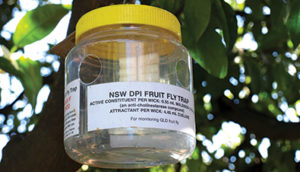Read the latest information on
Foot-and-mouth disease

The main control measures during early spring include monitoring traps to identify when adult flies are first active, and control measures such as protein bait sprays and traps
Spring, as the first fruits start to form, is the time to make sure your fruit fly management practices are up to date to protect your produce and nearby properties.
While they are found in different parts of the country, similar control methods and strategies can be used to control the two main pest species of fruit fly in Australia: the Queensland fruit fly and the Mediterranean fruit fly.
“The best approaches to control fruit fly include different activities throughout the year to target aspects of their behaviour,” said fruit fly specialist Christina Cook*.
“Starting these activities too late will allow fruit flies to get a foothold and make control later in the season more difficult. Early planning is essential.”
While fruit flies may be active all year in tropical regions, during spring the pest’s populations either become active or increase in size due to the warmer temperatures and available plants.
“The main measures during early spring include monitoring traps to identify when adult flies are first active, and control measures such as protein bait sprays and traps,” Christina said.
In early spring, female flies become active and look for a source of protein so that they can produce their eggs, which they lay in the maturing or ripening fruit of a suitable host plant.
Depending on your location, by mid to late spring the first eggs may have been laid in ripening fruit where the larvae will quickly develop
The fruit fly larvae feed on the inside of the fruit causing the fruit to rot internally and fall from the tree early. The fully mature larvae then leave the fallen fruit to burrow into the soil.
In the soil the fruit fly larvae become inactive and change into small, hard pupae which are oval shaped and of a light to dark brown colour. Inside the pupal case the adult fruit fly develops.
Adult flies will emerge from the pupae in as little as seven days during summer and will then mature, breed, and lay eggs of their own.
By summer, fruit flies are likely to be at their most active. In cool regions they might be completing their first life cycle, while in warmer regions they might already have completed two or more generations. As a single female fruit fly can lay hundreds of eggs, the population can increase rapidly.
Many of the measures used in spring are still appropriate in summer. Fallen fruit should be collected and destroyed to remove the possibility of fruit flies developing in the fallen fruit.
“The recommended technique for backyard growers to destroy the collected fruit is to place the fruit in a sealed, black plastic bag and leave it in the sun for three or more days,” said Christina.
“Commercial growers are advised to apply orchard hygiene practices, including disposing of collected fruit by deep burial.”
“Other measures, such as using mesh screen to prevent female fruit flies laying their eggs in your crop, may also be appropriate during this time if fruit fly pressures are high.”
“Fruit fly can be incredibly damaging to both home garden crops and commercial crops. As such, all members of the community need to work together to manage fruit fly,” Christina urged.
Now that it is spring you should have begun implementing measures already or, if not, be considering what options are best to implement as soon as possible.
Visit the ‘Controlling fruit fly’ page on the Prevent Fruit Fly website for more in-depth information on fruit fly management strategies to help you determine which methods are right for you.
*Christina Cook is employed by Plant Health Australia. She is the Manager of the National Fruit Fly Council which brings together government, researcher funding groups and growers to develop a national, cost-effective and sustainable approach to managing Mediterranean fruit fly and Queensland fruit fly across Australia.